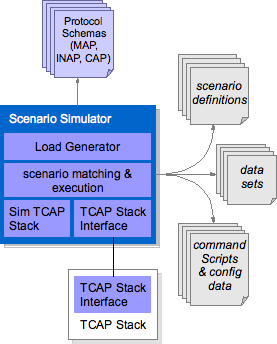The Scenario Simulator is a new, very powerful and flexible testing tool for simulating traffic in SS7 networks.
Each supported SS7 protocol is specified by a protocol schema. A protocol schema defines the types of messages and fields which are valid for a particular protocol.
You can use the scenario simulator to generate traffic (for example, to emulate an SSF) or to receive traffic (for example, to emulate an SCP or HLR) for functional and load testing. Imagine, for instance, you are working on a VPN-style application. You can write scenario definitions covering all the ways your application can interact with the switch, and also all the ways your application can interact with an HLR. The Scenario Simulator incorporates powerful scenario-matching technology and applies the most appropriate scenario based on the messages sent and received.

You use the scenario simulator for testing network elements and services by building a test environment with:
-
test cases defined as scenario definitions — Each scenario definition (defined with the Scenario Editor) describes the end-to-end message flow for a particular call-flow use case. The Scenario Simulator can simulate many scenarios at the same time.
-
test data as data-sets — Tables of data used in scenario definitions during runtime. Data-sets can either be specified inline (inside the scenario), or in an external CSV file.
-
endpoints — You can configure physical network endpoints with an associated address. Endpoints are bound to roles that are defined in the scenario definitions. The endpoints are part of the configuration data.
-
a TCAP stack — You configure the simulator to connect with an external TCAP stack or to use the built-in sim TCAP stack
|
|
Read the Scenario Simulator User Guide for more details about generating traffic with the Scenario Simulator for functional and load testing. |
